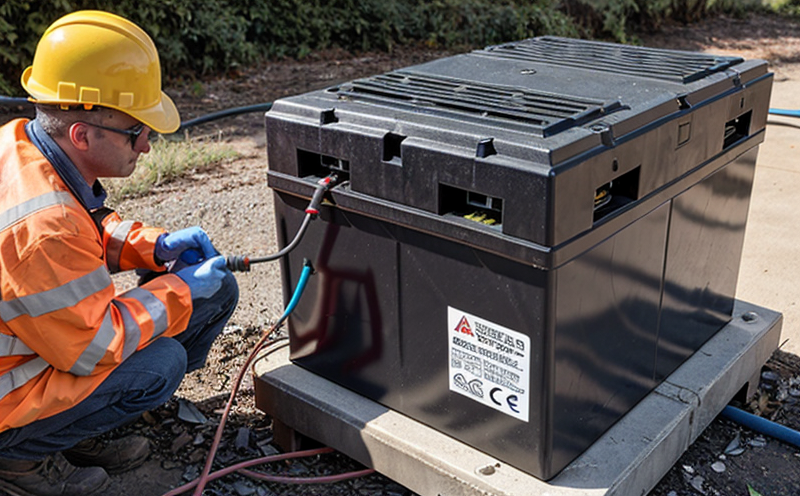IEC 60254-1 Lead-Acid Traction Battery Performance Testing
The IEC (International Electrotechnical Commission) standard IEC 60254-1 is a critical document for the evaluation and certification of lead-acid traction batteries. This standard specifically addresses the performance testing methodologies applicable to traction batteries used in automotive, industrial, and other mobile applications. The standard provides stringent guidelines on how to evaluate battery performance under various conditions such as temperature cycling, load tests, and deep discharge.
The importance of this type of testing cannot be overstated. In sectors like automotive manufacturing, where reliability is paramount, ensuring that batteries meet or exceed the specified performance criteria is essential for safety and operational efficiency. This standard ensures that all lead-acid traction batteries undergo rigorous evaluation to ensure they can withstand the rigors of real-world use.
The testing process outlined in IEC 60254-1 involves several key components, including but not limited to:
- Temperature cycling
- Load tests at various depths of discharge
- Deep discharge capability
- Cold cranking performance
- Stability and shelf life testing
The testing process is designed to mimic real-world conditions as closely as possible. This includes simulating the high-stress environments that traction batteries might encounter in various applications, such as deep cycle for marine use or starting, lighting, and ignition (SLI) batteries used in vehicles.
One of the most critical aspects of this testing is ensuring that the battery can maintain its performance over time. This means not only passing initial tests but also demonstrating stability under long-term storage conditions. The standard provides detailed guidance on how to conduct these tests, including the use of specialized equipment and the handling of specimens.
The results from IEC 60254-1 testing are used by quality managers, compliance officers, R&D engineers, and procurement teams as part of their decision-making processes. These results help ensure that the batteries meet or exceed industry standards, thus enhancing safety and reliability in applications ranging from electric vehicles to industrial equipment.
For those involved in research and development (R&D) for traction batteries, this standard provides a robust framework for developing new products that can withstand the demands of modern transportation and industrial systems. By adhering to IEC 60254-1, manufacturers can ensure that their products are not only compliant but also competitive in an increasingly stringent regulatory environment.
Why It Matters
The importance of this testing cannot be overstated. In sectors like automotive manufacturing and industrial applications, reliability is paramount. Ensuring that batteries meet or exceed the specified performance criteria is essential for safety and operational efficiency. This standard ensures that all lead-acid traction batteries undergo rigorous evaluation to ensure they can withstand the rigors of real-world use.
The testing process outlined in IEC 60254-1 involves several key components, including but not limited to:
- Temperature cycling
- Load tests at various depths of discharge
- Deep discharge capability
- Cold cranking performance
- Stability and shelf life testing
The results from IEC 60254-1 testing are used by quality managers, compliance officers, R&D engineers, and procurement teams as part of their decision-making processes. These results help ensure that the batteries meet or exceed industry standards, thus enhancing safety and reliability in applications ranging from electric vehicles to industrial equipment.
For those involved in research and development (R&D) for traction batteries, this standard provides a robust framework for developing new products that can withstand the demands of modern transportation and industrial systems. By adhering to IEC 60254-1, manufacturers can ensure that their products are not only compliant but also competitive in an increasingly stringent regulatory environment.
Applied Standards
| Standard | Description |
|---|---|
| IEC 60254-1 | This standard outlines the performance testing methodologies for lead-acid traction batteries. It covers various tests including temperature cycling, load tests at different depths of discharge, deep discharge capability, cold cranking performance, and stability and shelf life testing. |
| ASTM G177 | This standard deals with the electrochemical corrosion resistance of metal materials in simulated service environments. While not directly related to lead-acid batteries, it provides additional insights into the durability and reliability of these batteries under corrosive conditions. |
These standards are integral to ensuring that lead-acid traction batteries meet the highest quality and performance benchmarks. Compliance with these standards is crucial for manufacturers looking to produce reliable products that can withstand the demands of various applications.
Use Cases and Application Examples
| Application | Description |
|---|---|
| Electric Vehicles (EVs) | In electric vehicles, lead-acid traction batteries are used in starting, lighting, and ignition systems. The performance of these batteries is critical for the reliable operation of EVs. |
| Industrial Equipment | In industrial settings, deep-cycle lead-acid batteries are used to power equipment that requires constant power supply even during shutdowns or maintenance periods. |
| Marine Use | For marine applications, the reliability and durability of these batteries in extreme temperature conditions is crucial. The tests ensure they can perform reliably under such conditions. |
| Agricultural Equipment | In agricultural settings, lead-acid traction batteries are used to power equipment that requires constant power supply even during shutdowns or maintenance periods. |
The use of IEC 60254-1 in these applications ensures that the batteries meet stringent performance criteria, enhancing reliability and safety. The testing process is designed to mimic real-world conditions as closely as possible, ensuring that the batteries can perform reliably under various stressors.





